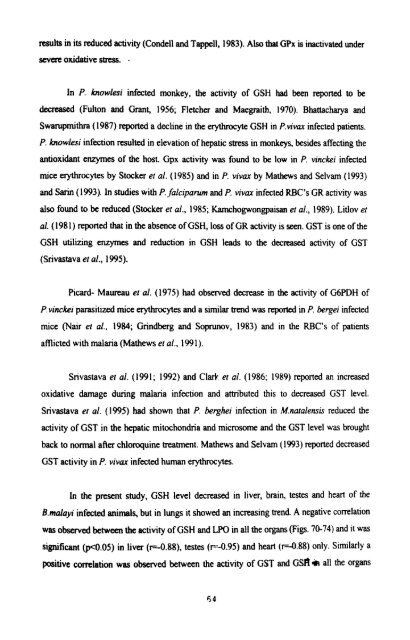effect of infection of the filarial parasite brugia malayi - Pondicherry ...
effect of infection of the filarial parasite brugia malayi - Pondicherry ...
effect of infection of the filarial parasite brugia malayi - Pondicherry ...
Create successful ePaper yourself
Turn your PDF publications into a flip-book with our unique Google optimized e-Paper software.
esults in its reduced activity (Condell and Tappell, 1983). Also that GPx is inactivated under<br />
severe oxidative sees^. .<br />
In P. knowlesi infected monkey, <strong>the</strong> activity <strong>of</strong> GSH had been reported to be<br />
decreased (Fulton and Grant, 1956; Fletcher and Maepith. 1970). Bhattacharya and<br />
Swarupmithra (1987) reported a decline in <strong>the</strong> etythrocyte GSH In P.vivlu infected patients.<br />
P. knowlesi <strong>infection</strong> resulted in elevation <strong>of</strong> hepatic stress in monkeys, besides affecting <strong>the</strong><br />
antioxidant enzymes <strong>of</strong> <strong>the</strong> host. Gpx activity was found to be low in P. vinckei infected<br />
mice erythrocytes by Stocker et al. (1985) and in P. viva by Ma<strong>the</strong>ws and Selvam (1993)<br />
and Sarin (1 993). In studies with P. falcipanrm and P. viva infected RBC's GR activity was<br />
also found to be reduced (Stocker et al., 1985; Kamchogwongpaisan el al., 1989). Litlov el<br />
al. (1981) reported that in <strong>the</strong> absence <strong>of</strong> GSH, loss <strong>of</strong> GR activity is seen. GST is one <strong>of</strong> <strong>the</strong><br />
GSH utilizing enzymes and reduction in GSH leads to <strong>the</strong> decreased activity <strong>of</strong> GST<br />
(Srivastava el al., 1995).<br />
Picard- Maureau er al. (1975) had observed decrease in <strong>the</strong> activity <strong>of</strong> G6PDH <strong>of</strong><br />
P.vinckei parasitized mice erythrocytes and a similar trend was reported in P. bergei infected<br />
mice (Nair et 01.. 1984; Grindberg and Soprunov, 1983) and in <strong>the</strong> RBC's <strong>of</strong> patients<br />
afflicted w~th malaria (Ma<strong>the</strong>ws er al., 1991).<br />
Srivastava er al. (1991; 1992) and Clark et al. (1986; 1989) reported an increased<br />
oxidative damage during malaria <strong>infection</strong> and attributed this to decreased GST level.<br />
Srivastava er al. (1995) had shown that P berghei <strong>infection</strong> in M.naraletzsis reduced <strong>the</strong><br />
activity <strong>of</strong> GST in <strong>the</strong> hepatic mitochondria and microsome and <strong>the</strong> GST level was brought<br />
back to normal aAer chloroquine treatment. Ma<strong>the</strong>ws and Selvam (1993) reported decreased<br />
GST activity in P. vivor infected human erythrocytes.<br />
In <strong>the</strong> present study, GSH level decreased in liver, brain, testes and heart <strong>of</strong> <strong>the</strong><br />
B,mafayi infected animals, but in lungs it showed an increasing trend. A negative correlation<br />
was observed between <strong>the</strong> activity <strong>of</strong> GSH and LPO in all <strong>the</strong> organs (Figs. 70-74) and it was<br />
significant w0.05) in liver (I=-0.88), testes (I=-0.95) and heari (r--0.88) only. Similarly a<br />
positive cornlation was observed between <strong>the</strong> activity <strong>of</strong> GST and GSI~ ip all <strong>the</strong> organs

















